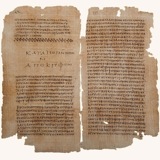Two
pages from the Nag Hammadi Library (Codex
II)
Inv. No. 10544
Papyrus
H: 28 cm, W: 15 cm
Jabal al-Taref, near Nag Hammadi, 4th century
In 1945 a farmer discovered 13 codices (books) near the
town of Nag Hammadi in Upper Egypt. They were sealed in a
large terracotta jar and wrapped in leather bindings. These
invaluable documents are written in Coptic and serve as the
primary source of gnosticism, a religious movement in the
early years of Christianity. The Gnostics (gnosis meaning
“knowledge” in Greek) believed that divine experience could
be achieved directly without a mediator like Jesus Christ
who was needed to gain knowledge of the divine truth.
Gnosticism was hindered by the official church from
spreading its “heretical” ideas. The Nag Hammadi Library
provides interesting information on religion, the Coptic
language, philosophy and bookbinding techniques. The left
page of the papyrus bears the end of the apocryphon
(“secret teachings”) of John and the beginning of the
gospel of Thomas. The right page of the papyrus is an
excerpt from “On the Origin of the World”. The originals of
the Nag Hammadi Library are kept in the manuscript archive
at the Coptic Museum in Old Cairo.
Frontispiece of
a gospel
Inv. No. 90
Oriental paper
Written by the Priest Abul-Fadl in Damascus, 1340
A.D.
By the 10th century Coptic documents began to be translated
into Arabic, the official language in Egypt following the
Arab conquest in 641 A.D. The title page of this gospel is
decorated with geometrical design comprising four polygons
with crosses framed by interlaced borders and foliage. This
ornate pattern of blue and gold shows a clear influence of
Mameluke art. The script is written in the kufic style (the
oldest form of Arabic calligraphy). Originally the gospel
was housed in the library of the Coptic Patriarchate and
could be borrowed for a maximum of 5 days.
The
epistles of St. Paul, the Catholic epistles and the acts
in Copto-Arabic
Inv. No. 146
Paper
The Church of St. Mercurius (Abu Sayfayn), Old Cairo, 1249
A.D.
The titles of each book are written inside the frontispiece
and illuminated in gold and colored pigments. This
miniature depicts the four apostles: James, Peter, John and
Jude.
Listen to this text
in Coptic >>
Psalmody
Inv. No. 4091
Vegetable paper
Unknown provenance, 1743 A.D.
A psalmody consists of religious songs, prayers and poems
and plays a major role in the Coptic-Orthodox liturgy and
personal devotion. This example is written in Coptic with a
transliteration into Arabic and is decorated on various
pages. This Folio 177v features Moses and God speaking to
him from within a Burning Bush.
Lectionary
for Holy Week, with Homilies
Inv. No. 1017
Paper
The Church of Holy Virgin at Haret Zuwayla, Cairo, 1625
A.D.
This lavish liturgical manuscript of readings used in the
service of the Holy Week, presents a Coptic-Arabic
bilingual text in adjacent columns. The frontispiece,
facing the opening page of the text, features a cross
illuminated in gold and blue pigment.
The Four
Gospels
Inv. No. 147
Linen paper
Unknown provenance, 1226 A.D.
The four Gospels in Arabic are decorated with punctuation
marks as gilt rosettes and miniatures of the four
evangelists. This illumination shows St. John painted in
tempera and gold.





